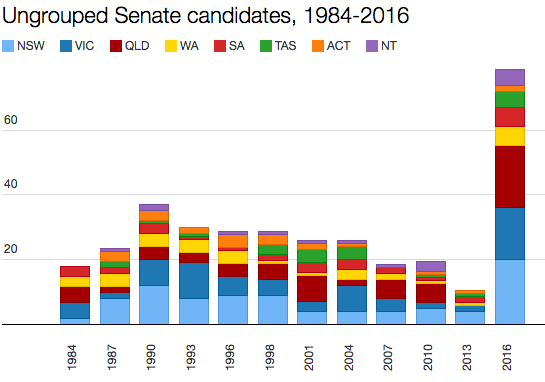Nominations were declared at midday yesterday, and I’ve just finished updating the candidate lists for each seat and the eight Senate races.
I wrote speculatively about the number of candidate nominations on Thursday in the Guardian. At the time of writing, 772 House of Representatives candidates had been identified, and I suggested that the final number would likely be one of the smallest in recent years.
The number jumped to 994, but this is still relatively low. Over 1000 candidates nominated for the lower house in 1998, 2001, 2004 and 2007, before dropping to under 900 in 2010 before a record number of candidates nominated in 2013.
The median number of candidates per seat dropped from eight to six, with twelve seats having three or four candidates on the ballot.
In the Senate, most states will have slightly smaller ballot papers than in 2013. Ballots in New South Wales, Victoria, Tasmania and the territories have each shrunk slightly, while they have grown slightly in Western Australia and Queensland.
The size of the ballot paper has some relationship to the population of the state, with bigger states having more parties running. South Australia was an outlier in 2013, and we’ve seen a drop in groups running in South Australia.
Despite the steady number of groups running, a record 631 candidates are running, thanks to parties running more candidates for the double dissolution.
While some may argue that the large ballot papers indicates that Senate voting reform failed to limit the increase in ballot sizes, I would argue that Senate ballots would have likely grown even further in 2016 without the reforms, and we should see smaller ballots at the first half-Senate election in 2019.
One interesting element in the Senate nominations was the large number of ungrouped candidates.
Ungrouped candidates have been largely a relic of an earlier era – candidates relegated to the end of the ballot paper, and not able to receive above-the-line votes. Generally ungrouped candidates have received extremely small votes, and are largely irrelevant to the contest.
While most commentary on the recent Senate reforms focused on changes to above-the-line voting, the laws also made it significantly easier to vote below the line. It was previously necessary to number at least 90% of boxes. Any below-the-line vote numbered 1-6 will now be formal (although voters will be instructed to number twelve boxes).
Now that below-the-line voting has become significantly easier, we’ve seen a response as a large number of candidates have nominated as sole ungrouped candidates. Before this year, the record for the most ungrouped candidates was 37 in 1990, and this number declined until only eleven nominated in 2013. This year that number is 79 – more than twice the previous record, and seven times the 2013 figure.
Of course, all serious parties are running in groups, and will benefit from above the line voting. It’s still substantially easier to make sure your preference count by numbering boxes above the line, and I expect these ungrouped candidates will still poll poorly, but it’s an interesting trend.




Hello Ben
I have downloaded all this data from the CSV downloads.
This is not enough for my analyses – I also need access to the Media Feed Pre-load data. – especially Candidate IDs etc.
The manual says it should appear on the Mon or Tues following nominations – but so far, no go.
If you know where it is (or if it’s just late), could you contact me please. AEC are not responding to my requests on this.
Cheers
Geoff Lambert
Sorry I can’t help you.
At ease – the number went up this evening on the test site
Geoff
Comments are closed.